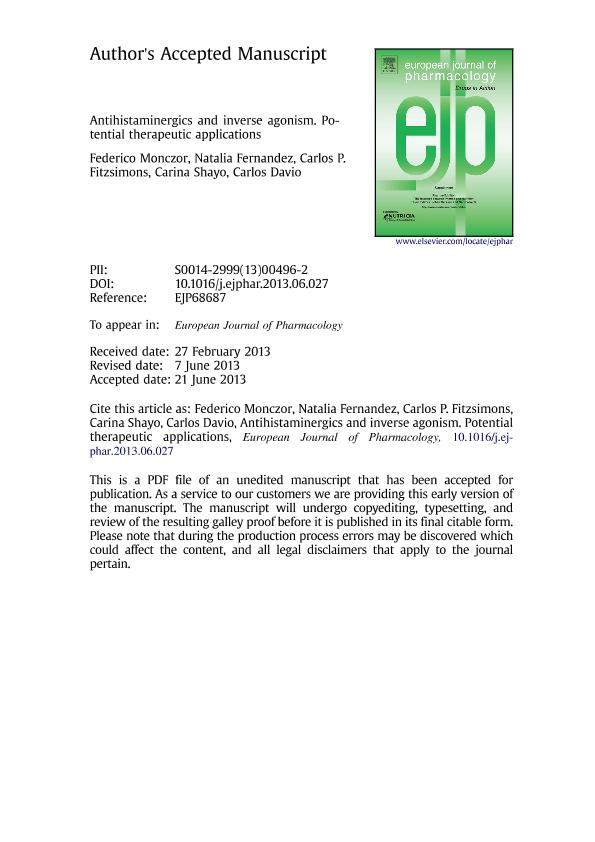Artículo
Antihistaminergics and inverse agonism. Potential therapeutic applications
Monczor, Federico ; Fernández, Natalia Brenda
; Fernández, Natalia Brenda ; Fitzsimons, Carlos; Shayo, Carina Claudia
; Fitzsimons, Carlos; Shayo, Carina Claudia ; Davio, Carlos Alberto
; Davio, Carlos Alberto
 ; Fernández, Natalia Brenda
; Fernández, Natalia Brenda ; Fitzsimons, Carlos; Shayo, Carina Claudia
; Fitzsimons, Carlos; Shayo, Carina Claudia ; Davio, Carlos Alberto
; Davio, Carlos Alberto
Fecha de publicación:
09/2013
Editorial:
Elsevier
Revista:
European Journal of Pharmacology
ISSN:
0014-2999
Idioma:
Inglés
Tipo de recurso:
Artículo publicado
Clasificación temática:
Resumen
The accurate characterization of the molecular mechanisms involved in the action of receptor ligands is important for their appropriate therapeutic use and safety. It is well established that ligands acting at the histamine system currently used in the clinic exert their actions by specifically antagonizing G-protein coupled H1 and H2 receptors. However, most of these ligands, assumed to be neutral antagonists, behave as inverse agonists displaying negative efficacy in experimental systems. This suggests that their therapeutic actions may involve not only receptor blockade, but also the decrease of spontaneous receptor activity. The mechanisms whereby inverse agonists achieve negative efficacy are diverse. Theoretical models predict at least three possible mechanisms, all of which are supported by experimental observations. Depending on the mechanism of action engaged, the inverse agonist could interfere specifically with signaling events triggered by unrelated receptors. This possibility opens up new venues to explain the therapeutic actions of inverse agonists of the histamine receptor and perhaps new therapeutic applications.
Palabras clave:
Histamine Receptors
,
Antihistaminergics
,
Inverse Agonism
,
Adverse Effects
Archivos asociados
Licencia
Identificadores
Colecciones
Articulos(IBYME)
Articulos de INST.DE BIOLOGIA Y MEDICINA EXPERIMENTAL (I)
Articulos de INST.DE BIOLOGIA Y MEDICINA EXPERIMENTAL (I)
Articulos(OCA HOUSSAY)
Articulos de OFICINA DE COORDINACION ADMINISTRATIVA HOUSSAY
Articulos de OFICINA DE COORDINACION ADMINISTRATIVA HOUSSAY
Citación
Monczor, Federico; Fernández, Natalia Brenda; Fitzsimons, Carlos; Shayo, Carina Claudia; Davio, Carlos Alberto; Antihistaminergics and inverse agonism. Potential therapeutic applications; Elsevier; European Journal of Pharmacology; 715; 9-2013; 26-32
Compartir
Altmétricas



